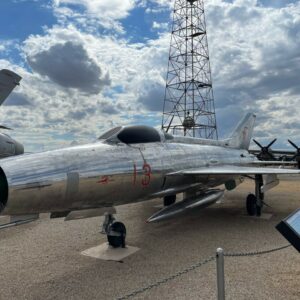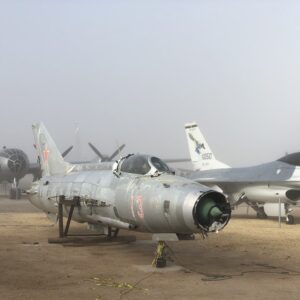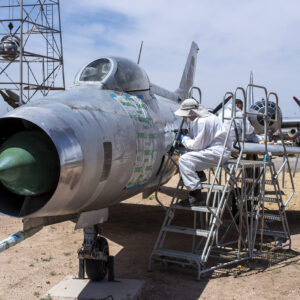Completed MiG-21
The National Museum of Nuclear Science & History received a Russian Mikoyan-Gurevich MiG-21 jet fighter, its third aircraft acquisition in the past five years, the week of December 18, 2017.
The MiG-21 is a supersonic jet fighter and interceptor aircraft designed by the Mikoyan-Gurevich Design Bureau in the Soviet Union. These aircraft were designed in the early 1950s, used primarily between 1959 and 1985 by many communist countries. It was also the type of aircraft used predominantly in Vietnam by the Northern Vietnamese Air Force.
“It is thrilling to add this aircraft to our collection as the only non-American plane in Heritage Park,” said Jim Walther, Museum Director. “This jet fighter is a Cold War icon and will truly add another dimension to our Cold War exhibitions at the museum.”
Very little background is known on this specific airplane coming to the National Museum of Nuclear Science & History, as much of its lifespan has been classified. It is joining the museum’s collection, being transported via flatbed truck from the 309th Aerospace Maintenance and Regeneration Group (AMARG) – often called the Boneyard – located on the Davis-Monthan Air Force Base in Tucson, Arizona. Extensive planning and preparations have been made for the relocation of this 19,230 lb, 48 foot 2 inch airplane.
Upon arrival to the Museum, the deconstructed MiG-21 became focus of a special initiative within “Operation Preservation” – a multi-year campaign to restore the iconic aircraft in Heritage Park – where the aircraft was reassembled by museum volunteers, and the exterior display surfaces were reconditioned and polished.
The MiG-21 is on permanent display in the museum’s nine-acre outdoor exhibit area, positioned in-between the museum’s F-16 Fighting Falcon, the A-7 Corsair II and the F-105 Thunderchief. Seemingly surrounded by the American aircraft.
Assembly and restoration of the MiG-21 began in the Spring of 2018 under the supervision of Brigadier General (Ret.) Jay Bledsoe, Heritage Park Restoration Project Manager, and was funded by donations received from supporters and entities with personal ties to the museum. Due to COVID-19 and the museum's shutdown for six months during 2020, the restoration took longer than expected. The restoration project was completed in the summer of 2021.







